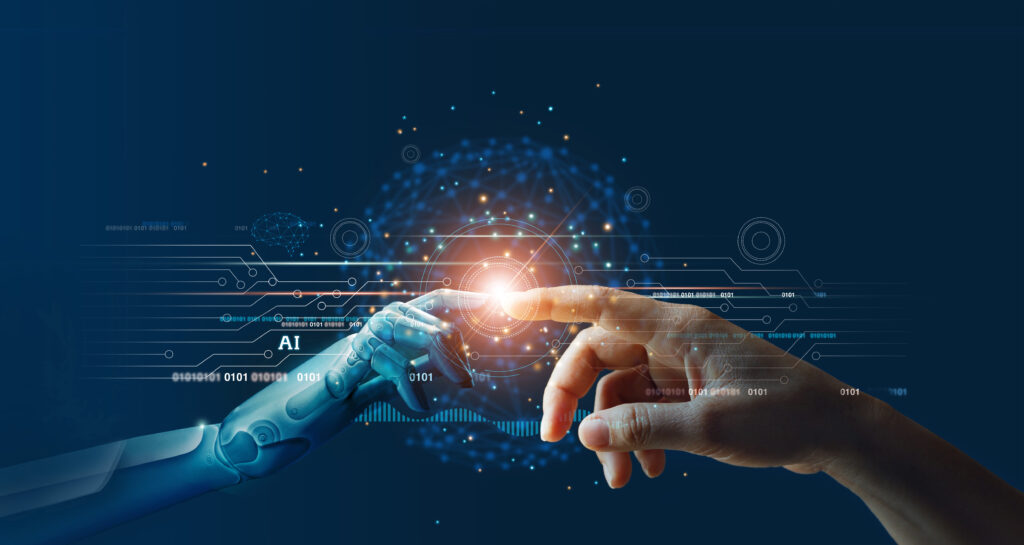AI in Manufacturing Has Its Benefits

By: Dean Simmons
Artificial intelligence (AI) is no longer a far-fetched concept but a reality that has already begun to revolutionize various industries. AI has the potential to transform the manufacturing industry in several ways, improving productivity, reducing downtime, enhancing quality, and saving costs.
Google CEO Sundar Pichai recently commented on AI saying, “The revolution is coming faster than you know. It’s a profound technology still in its early days that will impact every product across every company.”
Getting Started with AI in Manufacturing
Introducing AI to a business can be daunting, and some manufacturers may be skeptical about whether the investment is justified. However, according to the National Institute of Standards and Technology (NIST), successful AI implementation boils down to the three P’s: problem, persona, and process.
The first step is identifying a problem or issue for AI to solve. Then the right people need to be involved for implementation to succeed. People in leadership positions, operations, IT and digital technology, and finance contribute to properly adopting AI at their company. A well-thought-out approach to process helps to determine the right way to tackle problems using AI.
The Role of AI Technologies in Manufacturing
Artificial intelligence is already improving the manufacturing process in a variety of ways. AI technologies such as machine learning and deep learning help to better analyze data and enable smarter decision-making.
Machine learning uses algorithms and data to automatically learn from underlying patterns without actually being programmed to do so. Deep learning is a derivative of machine learning that uses neural networks, which is essentially a method of AI that teaches computers to process data in a way that is inspired by the human brain, to analyze things like images and videos.
Industrial robots with AI capabilities, such as collaborative robots, aka Cobots, are autonomous objects that manage tasks on their own. Robots using AI in manufacturing are able to automate monotonous operations and eliminate or minimize human error, allowing a manufacturer to refocus workforce attention on more productive and profitable areas of their business.
The Benefits and Financial Impact of AI on Manufacturing
Implementing AI in manufacturing means using data to make actionable decisions faster and more accurately than a person can.
There are several key benefits of using artificial intelligence in manufacturing workflow, including:
-
- Improved efficiency: AI can help optimize manufacturing processes by identifying areas for improvement and reducing waste, which can increase productivity and reduce costs.
- Enhanced quality control: AI-powered systems can detect defects in real-time, preventing faulty products from leaving the factory and reducing the need for manual inspection.
- Increased safety: AI can monitor workers and equipment in real-time, alerting supervisors to potential safety hazards and helping to prevent accidents.
- Cost savings: By optimizing processes and reducing waste, AI can help manufacturers save money on materials, labor, and other expenses.
- Improved flexibility: AI-powered systems can quickly adapt to changes in demand, allowing manufacturers to respond to market fluctuations and adjust production schedules accordingly.
From a financial perspective, NIST has indicated that AI can have a significant impact on areas such as:
-
- Predictive maintenance. AI algorithms can analyze data from sensors, maintenance logs, and other sources to predict when equipment will need maintenance, allowing for proactive repairs, reducing downtime, and saving money.
- Predictive quality. Predicting and reducing failures can yield significant cost savings.
- Scrap reduction. Using metrics and data to measure and predict behavior across product specifications can minimize scrap and maximize product quality.
- Increasing yield/throughput. Predicting the timing of when a machine or process will no longer meet given specifications allows a business to proactively do what’s needed to bring it back into specification, reducing quality passes.
- Demand and inventory forecasting. Thoroughly understanding plant operations and the data supporting production enables an organization to forecast the demand and movement of critical parts, resulting in significant inventory savings.
AI as a Game Changer
Despite some skepticism about introducing artificial intelligence into manufacturing, the use of AI can lead to increased efficiency, improved quality control, greater safety, and significant cost savings. AI has the potential to transform productivity and performance throughout manufacturing operations, adding value and driving solutions.
Technologies including machine learning, deep learning, and robotic applications will lead the AI transformation in the manufacturing industry. According to the Capgemini Research Institute, with so much data being produced by Industry 4.0 initiatives and smart factories, manufacturers will increasingly turn to AI, particularly in the areas of production, maintenance, and quality.
The bottom line is that companies that embrace access to AI technology have a competitive advantage. The level of automation associated with this technology across the economy is just scratching the surface. AI and automation have implications for building and growing workforce skills, learning to work alongside machines, and complementing workflow and production capabilities on the shop floor today.
Related Items
[PDF] A Guide to Digital Transformation
This Guidebook is meant to help manufacturers in the supply base begin to transform their operations for MBD.
[Blog] Technology and Automation in an Era of Crisis
Modular equipment that can be easily reconfigured is immensely helpful. Any technology that allows the people who set up and operate equipment to be guided, in order to augment their skillsets, is extremely helpful.
[Blog] The Future of Connected Devices
As we look to the future of connected devices and the technology behind them, we need to consider their cybersecurity implications.
